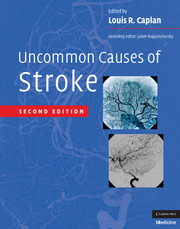75 results
Contributors
-
-
- Book:
- Stroke Syndromes, 3ed
- Published online:
- 05 August 2012
- Print publication:
- 12 July 2012, pp vii-x
-
- Chapter
- Export citation
Chapter 29 - Arterial territories of the human brain
- from Section 2 - Vascular topographic syndromes
-
-
- Book:
- Stroke Syndromes, 3ed
- Published online:
- 05 August 2012
- Print publication:
- 12 July 2012, pp 329-343
-
- Chapter
- Export citation
PART IX: - OTHER MISCELLANEOUS CONDITIONS
-
- Book:
- Uncommon Causes of Stroke
- Published online:
- 06 January 2010
- Print publication:
- 09 October 2008, pp 533-544
-
- Chapter
- Export citation

Uncommon Causes of Stroke
-
- Published online:
- 06 January 2010
- Print publication:
- 09 October 2008
Index
-
- Book:
- Uncommon Causes of Stroke
- Published online:
- 06 January 2010
- Print publication:
- 09 October 2008, pp 545-560
-
- Chapter
- Export citation
List of Contributors
-
-
- Book:
- Uncommon Causes of Stroke
- Published online:
- 06 January 2010
- Print publication:
- 09 October 2008, pp ix-xiv
-
- Chapter
- Export citation
PART V: - SYSTEMIC DISORDERS THAT ALSO INVOLVE THE CEREBROVASCULAR SYSTEM
-
- Book:
- Uncommon Causes of Stroke
- Published online:
- 06 January 2010
- Print publication:
- 09 October 2008, pp 311-432
-
- Chapter
- Export citation
Uncommon Causes of Stroke - Title page
-
-
- Book:
- Uncommon Causes of Stroke
- Published online:
- 06 January 2010
- Print publication:
- 09 October 2008, pp iii-iii
-
- Chapter
- Export citation
PART VII: - VENOUS OCCLUSIVE CONDITIONS
-
- Book:
- Uncommon Causes of Stroke
- Published online:
- 06 January 2010
- Print publication:
- 09 October 2008, pp 497-504
-
- Chapter
- Export citation
43 - MICROSCOPIC POLYANGIITIS AND POLYARTERITIS NODOSA
- from PART V: - SYSTEMIC DISORDERS THAT ALSO INVOLVE THE CEREBROVASCULAR SYSTEM
-
-
- Book:
- Uncommon Causes of Stroke
- Published online:
- 06 January 2010
- Print publication:
- 09 October 2008, pp 311-330
-
- Chapter
- Export citation
PART VI: - NONINFLAMMATORY DISORDERS OF THE ARTERIAL WALL
-
- Book:
- Uncommon Causes of Stroke
- Published online:
- 06 January 2010
- Print publication:
- 09 October 2008, pp 433-496
-
- Chapter
- Export citation
PART I: - INFECTIOUS AND INFLAMMATORY CONDITIONS
-
- Book:
- Uncommon Causes of Stroke
- Published online:
- 06 January 2010
- Print publication:
- 09 October 2008, pp 1-100
-
- Chapter
- Export citation
PART III: - VASCULAR CONDITIONS OF THE EYES, EARS, AND BRAIN
-
- Book:
- Uncommon Causes of Stroke
- Published online:
- 06 January 2010
- Print publication:
- 09 October 2008, pp 235-262
-
- Chapter
- Export citation
Contents
-
- Book:
- Uncommon Causes of Stroke
- Published online:
- 06 January 2010
- Print publication:
- 09 October 2008, pp v-viii
-
- Chapter
- Export citation
Copyright page
-
- Book:
- Uncommon Causes of Stroke
- Published online:
- 06 January 2010
- Print publication:
- 09 October 2008, pp iv-iv
-
- Chapter
- Export citation
Uncommon Causes of Stroke - Half title page
-
- Book:
- Uncommon Causes of Stroke
- Published online:
- 06 January 2010
- Print publication:
- 09 October 2008, pp i-ii
-
- Chapter
- Export citation
PART II: - HEREDITARY AND GENETIC CONDITIONS AND MALFORMATIONS
-
- Book:
- Uncommon Causes of Stroke
- Published online:
- 06 January 2010
- Print publication:
- 09 October 2008, pp 101-234
-
- Chapter
- Export citation
PART IV: - DISORDERS INVOLVING ABNORMAL COAGULATION
-
- Book:
- Uncommon Causes of Stroke
- Published online:
- 06 January 2010
- Print publication:
- 09 October 2008, pp 263-310
-
- Chapter
- Export citation
PART VIII: - VASOSPASTIC CONDITIONS AND OTHER MISCELLANEOUS VASCULOPATHIES
-
- Book:
- Uncommon Causes of Stroke
- Published online:
- 06 January 2010
- Print publication:
- 09 October 2008, pp 505-532
-
- Chapter
- Export citation
35 - MICROANGIOPATHY OF THE RETINA, INNER EAR, AND BRAIN: SUSAC’S SYNDROME
- from PART III: - VASCULAR CONDITIONS OF THE EYES, EARS, AND BRAIN
-
-
- Book:
- Uncommon Causes of Stroke
- Published online:
- 06 January 2010
- Print publication:
- 09 October 2008, pp 247-254
-
- Chapter
- Export citation



